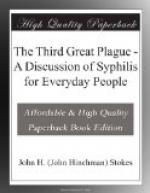On the whole, then, it is conservative to estimate that one man in ten has syphilis. Taking men and women together on the basis of one of the latter to five of the former, and excluding those under fifteen years of age from consideration, this country, with a population of 91,972,266,[5] should be able to muster a very considerable army of 3,842,526, whose influence can give a little appreciated but very undesirable degree of hyphenation to our American public health. In taking stock of ourselves for the future, and in all movements for national solidarity, efficiency, and defense, we must reckon this force of syphilo-Americans among our debits.
[5] Figures based on 1910 census.
THE PRIMARY STAGE OF SYPHILIS
+The So-called Stages of Syphilis.+—The division of the course of syphilis into definite stages is an older and more arbitrary conception than the one now developing, and was based on outward signs of the disease rather than on a real understanding of what goes on in the body during these periods. The primary stage was supposed to extend from the appearance of the first sore or chancre to the time when an eruption appeared over the whole body. Since the discovery of the Spirochaeta pallida, the germ of the disease, our knowledge of what the germ does in the body, where it goes, and what influence it has upon the infected individual, has rapidly extended. We now appreciate much more fully than formerly that at the very beginning of the disease there is a time when it is almost purely local, confined to the first sore itself, and perhaps to the glands or kernels in its immediate neighborhood. Thorough and prompt treatment with the new and powerful aid of salvarsan ("606”) at this stage of the disease can kill all the germs and prevent the disease from getting a foothold in the body which only years of treatment subsequently can break. This is the critical moment of syphilis for the individual and for society, and its importance and the value of treatment at this time cannot be too widely understood.
+Peculiarities of the Germ.+—Many interesting facts about the Spirochaeta pallida explain peculiarities in the disease of which it is the cause. Many germs can be grown artificially, some in the presence of air, others only when air is removed. The germ of syphilis belongs in the latter class. The germ that causes tuberculosis, a rod-like organism or bacillus, can stand drying without losing its power to produce the disease, and has a very appreciable ability to resist antiseptic agents. If the germ of syphilis were equally hard to kill, syphilis would be an almost universal disease. Fortunately it dies at once on drying, and is easily destroyed by the weaker antiseptics provided it has not gained a foothold on favorable ground. Its inability to live long in the presence of air confines the source of infection largely to those parts of the body which




